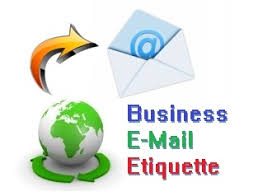Etiquette for Business Emails

Etiquette for Business Emails
Etiquette for Business Emails. Writing an email to one’s sister or best friend is very different from composing business emails for coworkers or external audiences. A higher level of email etiquette can improve your professional image online. It’s important to pay close attention to each element of a business email: the subject line, the greeting, the introduction, the body, and the closing. Errors in any of these elements can cloud your meaning or give a reader the wrong impression.
A Concise Subject Line
The subject line may be the most important component of a business email. It’s the reader’s first impression, the first clue as to what the email is about. It should be just a few words long, like the title of a book, and it should concisely describe the content of the email.
For example, if the email’s purpose is to schedule a meeting, the subject lines “Meeting” or “Scheduling a Meeting” are too vague. If the reader doesn’t know what the meeting is about, he or she might not read or respond to the email. A subject line such as “Meeting Requested next week re: Budget Forecasting” is more specific and offers a time frame and meeting information to provide context for the reader.
Professional Greetings
The formality of the greeting depends on the audience, but in general words like “Hey” or “Hi” should be avoided. If the audience is familiar, such as close coworkers, a relatively informal greeting such as “Hello” or “Hello everyone” is appropriate. For unfamiliar audiences, a formal letter greeting like “Dear Ms. Smith” should be used.
Some readers consider it abrupt when a writer does not use a greeting, so it’s always best to include one, and choose a greeting that is appropriate for both the audience and the context of the email.
Clear, Concise Content
A business email should not be too long, or the reader may never read the whole message. Many people now check email on their mobile devices, so writers should take this into consideration when writing. Generally two to three paragraphs is acceptable if there is significant content to cover.
Be careful to choose words wisely and make sure the purpose of the email is clear in the first sentence. If the reader has to scroll to the bottom of the email to understand why it was sent, he or she may miss the message altogether. Keep sentences and paragraphs relatively short and informative.
A Quick and Clear Closing
The closing of a business email may indicate a call for action if one is intended; or, it may simply serve as a good will statement towards the reader. In any case, the closing of a business email should be just one sentence.
An email signature may be part of the closing and may include the author’s name and company affiliation. It may also include contact information for the author. A simple email signature can be very effective and may give the reader credibility if the audience does not know the writer.
Other Tips for Professional Business Emails
File attachments should be appropriately named so that the reader knows what the file contains. Attachments should always be referenced in the body of the email. If emailing a document that will be revised and sent back, it is often appropriate to include the last date of revision in the file name and to change that information each time the file is sent. This way multiple readers always know which copy of the file is the most recent.
Always avoid emoticons and excessive punctuation in a business email, and check it for spelling errors before sending it out. Also double-check the recipients to ensure that only the intended audience receives the message.
